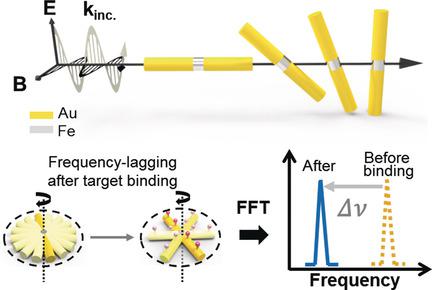当前位置:
X-MOL 学术
›
Angew. Chem. Int. Ed.
›
论文详情
Our official English website, www.x-mol.net, welcomes your
feedback! (Note: you will need to create a separate account there.)
Fourier Transform Surface Plasmon Resonance (FTSPR) with Gyromagnetic Plasmonic Nanorods
Angewandte Chemie International Edition ( IF 16.1 ) Pub Date : 2018-01-16 , DOI: 10.1002/anie.201710619 Insub Jung 1 , Haneul Yoo 2 , Hee-Jeong Jang 1 , Sanghyun Cho 1 , Kyungeun Lee 1 , Seunghun Hong 2 , Sungho Park 1
Angewandte Chemie International Edition ( IF 16.1 ) Pub Date : 2018-01-16 , DOI: 10.1002/anie.201710619 Insub Jung 1 , Haneul Yoo 2 , Hee-Jeong Jang 1 , Sanghyun Cho 1 , Kyungeun Lee 1 , Seunghun Hong 2 , Sungho Park 1
Affiliation

|
An unprecedented active and dynamic sensing platform based on a LSPR configuration that is modulated by using an external magnetic field is reported. Electrochemically synthesized Au/Fe/Au nanorods exhibited plasmonically active behavior through plasmonic coupling, and the middle ferromagnetic Fe block responded to a magnetic impetus, allowing the nanorods to be modulated. The shear force variation induced by the specific binding events between antigens and antibodies on the nanorod surface is used to enhance the sensitivity of detection of antigens in the plasmonics‐based sensor application. As a proof‐of‐concept, influenza A virus (HA1) was used as a target protein. The limit of detection was enhanced by two orders of magnitude compared to that of traditional LSPR sensing.
中文翻译:

旋磁等离子体纳米棒的傅立叶变换表面等离子体共振(FTSPR)
报告了一种前所未有的基于LSPR配置的主动和动态感测平台,该平台通过使用外部磁场进行调制。电化学合成的Au / Fe / Au纳米棒通过等离激元耦合表现出等离激元活性,并且中间的铁磁Fe块对磁动力作出响应,从而可以对纳米棒进行调制。由基于纳米棒表面的抗原和抗体之间的特异性结合事件引起的剪切力变化可用于增强在基于等离激元的传感器应用中检测抗原的灵敏度。作为概念验证,甲型流感病毒(HA1)被用作目标蛋白。与传统的LSPR感应相比,检测极限提高了两个数量级。
更新日期:2018-01-16
中文翻译:

旋磁等离子体纳米棒的傅立叶变换表面等离子体共振(FTSPR)
报告了一种前所未有的基于LSPR配置的主动和动态感测平台,该平台通过使用外部磁场进行调制。电化学合成的Au / Fe / Au纳米棒通过等离激元耦合表现出等离激元活性,并且中间的铁磁Fe块对磁动力作出响应,从而可以对纳米棒进行调制。由基于纳米棒表面的抗原和抗体之间的特异性结合事件引起的剪切力变化可用于增强在基于等离激元的传感器应用中检测抗原的灵敏度。作为概念验证,甲型流感病毒(HA1)被用作目标蛋白。与传统的LSPR感应相比,检测极限提高了两个数量级。











































 京公网安备 11010802027423号
京公网安备 11010802027423号